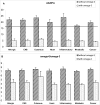A rapid method for determining arachidonic:eicosapentaenoic acid ratios in whole blood lipids: correlation with erythrocyte membrane ratios and validation in a large Italian population of various ages and pathologies
- PMID: 20105293
- PMCID: PMC2834683
- DOI: 10.1186/1476-511X-9-7
A rapid method for determining arachidonic:eicosapentaenoic acid ratios in whole blood lipids: correlation with erythrocyte membrane ratios and validation in a large Italian population of various ages and pathologies
Abstract
Background: Omega-3 and -6 polyunsaturated fatty acids (LCPUFA), are important for good health conditions. They are present in membrane phospholipids.The ratio of total n-6:n-3 LCPUFA and arachidonic acid:eicosapentaenoic acid (AA and EPA), should not exceed 5:1. Increased intake of n-6 and decreased consumption of n-3 has resulted in much higher, ca 10/15:1 ratio in RBC fatty acids with the possible appearance of a pathological "scenario". The determination of RBC phospholipid LCPUFA contents and ratios is the method of choice for assessing fatty acid status but it is labour intensive and time consuming.
Aims of the study: [i] To describe and validate a rapid method, suitable for large scale population studies, for total blood fatty acid assay; [ii] to verify a possible correlation between total n-6:n-3 ratio and AA:EPA ratios in RBC phospholipids and in whole-blood total lipids, [iii] to assess usefulness of these ratio as biomarkers of LCPUFA status.
Methods: 1 Healthy volunteers and patients with various pathologies were recruited.2 Fatty acid analyses by GC of methyl esters from directly derivatized whole blood total lipids and from RBC phospholipids were performed on fasting blood samples from 1432 subjects categorised according to their age, sex and any existing pathologies.AA:EPA ratio and the total n-6:n-3 ratio were determined.
Results: AA:EPA ratio is a more sensitive and reliable index for determining changes in total blood fatty acid and it is correlated with the ratio derived from extracted RBC phospholipids.
Conclusions: The described AA:EPA ratio is a simple, rapid and reliable method for determining n-3 fatty acid status.
Figures




References
-
- Berge JP, Barnathan G. Fatty acids from lipids of marine organisms: molecular biodiversity, roles as biomarkers, biologically active compounds, and economical aspects. [Review] Advances in Biochemical Engineering- Biotechnology. 2005;96:49–125. - PubMed
-
- INRAN: Linee guida per una sana alimentazione italiana. Internet. 2003;27 http://www.inran.it
-
- Whelan J. Antagonistic effects of dietary arachidonic acid and n-3 polyunsaturated fatty acids. J Nutr. 1996;126:1086S–1091S. - PubMed
Publication types
MeSH terms
Substances
LinkOut - more resources
Full Text Sources
Research Materials
Miscellaneous

